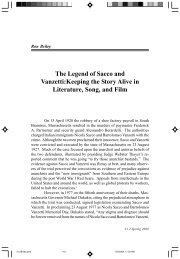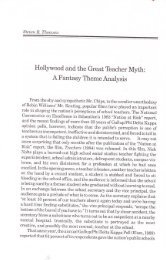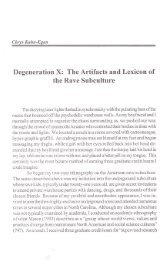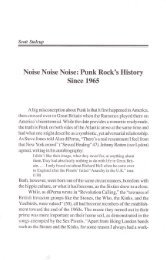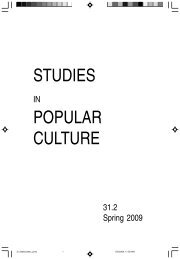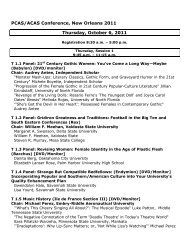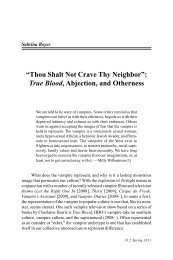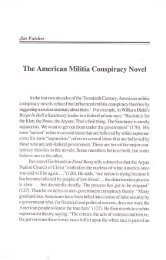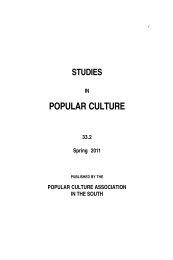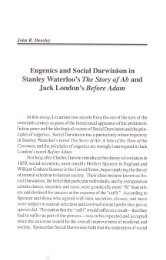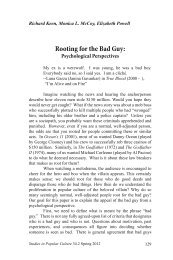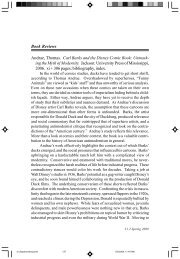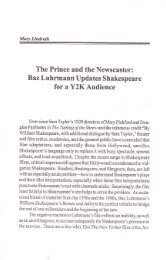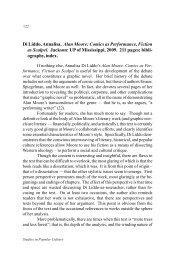'Sigmund Freud, Analyze This': How Madonna Situates - Popular ...
'Sigmund Freud, Analyze This': How Madonna Situates - Popular ...
'Sigmund Freud, Analyze This': How Madonna Situates - Popular ...
Create successful ePaper yourself
Turn your PDF publications into a flip-book with our unique Google optimized e-Paper software.
90 David Sigler<br />
endurable suffering. 16 The enigmatic tattoo presents a literalized case of<br />
the feminine jouissance that, as Lacan says, allows the Woman (the Lacanian<br />
strikethrough indicating her relationship to the symbolic order) 17 to enjoy<br />
not only through the signifier but also in direct relation to the Other (Seminar<br />
XX 64-77). As Lacan explains, some tattoos can be understood as<br />
materializations of the libido, and they “certainly [have] the function of<br />
being for the Other, of situating the subject in it, marking his [sic] place in<br />
the field of the group’s relations” (Seminar XI 205-206). Noting their<br />
“erotic function,” Lacan claims that with some tattoos, the subject “in<br />
short circuit, more directly than any other, succeeds” in integrating subjectivity<br />
and desire (Seminar XI 206). <strong>Madonna</strong>’s tattoo, in its direct assertion<br />
of the dialectical subversion of the subject and of that subject’s direct<br />
access to the Other, implies that even while <strong>Madonna</strong> may not have actually<br />
yet destroyed her ego, her ego nevertheless has been unseated, jeopardized,<br />
and self-alienated.18 Fittingly, once <strong>Madonna</strong> vanishes from the<br />
short-circuiting electric chair at the end of the music video, the letters from<br />
her tattoo appear as if burnt into the electric chair itself.19 This fresh<br />
mark of “no,” however, in this new context, seems to celebrate <strong>Madonna</strong>’s<br />
prolonging the road to death more than it documents the Name-of-the-<br />
Father: it appears as a marker of <strong>Madonna</strong>’s escape, and it appears<br />
seemingly because we have just seen the white fencing <strong>Madonna</strong> of another,<br />
seemingly unrelated scene shoot an arrow through the heart of the<br />
black fencing <strong>Madonna</strong> (which could possibly be read as Eros staving off<br />
Thanatos for awhile). 20<br />
In the lyrics, the music video, and the film, we see an intimate conversation<br />
emerging between <strong>Madonna</strong> and <strong>Freud</strong>. This conversation, we<br />
must remember, is thoroughly commoditized, and it must serve commercial<br />
purposes in a remarkably overdetermined way: the song is designed<br />
to serve as a commodity in its own right (as a hit single), as an advertisement<br />
for itself (in its music video), an advertisement for <strong>Madonna</strong> as construed<br />
as a brand unto herself, an advertisement for the film, and as a<br />
prominent part of the very film that it is supposed to advertise. In employing<br />
(and implying) concepts from Beyond the Pleasure Principle, Ma-<br />
Studies in <strong>Popular</strong> Culture



